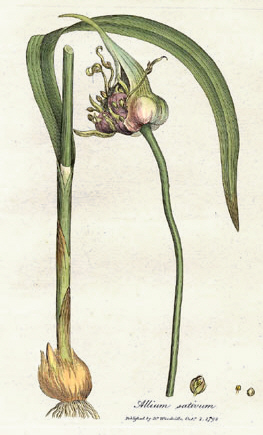
Chives, scientific name Allium schoenoprasum, is a species of flowering plant in the family Amaryllidaceae that produces edible leaves and flowers. Their close relatives include the common onions, garlic, shallot, leek, scallion, and Chinese onion.

Garlic is a species of bulbous flowering plant in the genus Allium. Its close relatives include the onion, shallot, leek, chive, Welsh onion, and Chinese onion. It is native to South Asia, Central Asia and northeastern Iran and has long been used as a seasoning worldwide, with a history of several thousand years of human consumption and use. It was known to ancient Egyptians and has been used as both a food flavoring and a traditional medicine. China produced 73% of the world's supply of garlic in 2021.

An onion, also known as the bulb onion or common onion, is a vegetable that is the most widely cultivated species of the genus Allium. The shallot is a botanical variety of the onion which was classified as a separate species until 2011. Its close relatives include garlic, scallion, leek, and chive.

In botany, a bulb is structurally a short stem with fleshy leaves or leaf bases that function as food storage organs during dormancy.

Allium tricoccum is a bulbous perennial flowering plant in the amaryllis family Amaryllidaceae. It is a North American species of wild onion or garlic widespread across eastern Canada and the eastern United States. Many of the common English names for this plant are also used for other Allium species, particularly the similar Allium ursinum, which is native to Europe and Asia. An edible plant, Allium tricoccum is used in a variety of North American and indigenous cuisines, and has also been used by Native Americans in traditional medicine. A French rendering (chicagou) of the Native American name for this plant is the namesake of the American city of Chicago.

Allium vineale is a perennial, bulb-forming species of wild onion, native to Europe, northwestern Africa and the Middle East. The species was introduced in Australia and North America, where it has become a noxious weed.

Allium drummondii, also known as Drummond's onion, wild garlic and prairie onion, is a North American species of onion native to the southern Great Plains of North America. It is found in South Dakota, Kansas, Nebraska, Colorado, Oklahoma, Arkansas, Texas, New Mexico, and northeastern Mexico.

Solo garlic, also known as single clove garlic, chinese garlic, monobulb garlic, single bulb garlic, or pearl garlic, is a type of Allium sativum (garlic). The size of the single clove differs from approximately 25 to 50 mm in diameter. It has the flavour of the garlic clove but is somewhat milder and slightly perfumed. The appearance is akin to that of a pickling onion, with white skin and often purple stripes. Compared to traditional garlic, Solo garlic offers the advantage of being easy to peel quickly.

Allium monanthum, the Korean wild chive, is a spring vegetable with minuscule bulbous roots that have a mild onion flavor and found in the woodlands of Korea, Japan, northeastern Russia (Primorye), and northeastern China.

Allium cernuum, known as nodding onion or lady's leek, is a perennial plant in the genus Allium. It grows in open areas in North America.

Allium caeruleum is an ornamental bulbous plant of the onion genus, native to Central Asia. In these regions, it is found on dry slopes, plains, and steppes.

Allium bisceptrum, also known as the twincrest onion or aspen onion, is a high elevation plant native to western United States. It is a perennial that thrives under damp and shady conditions or open meadows in California, Arizona, New Mexico, Nevada, Oregon, Washington, Idaho, and Utah.

Allium stipitatum, Persian shallot, is an Asian species of onion native to central and southwestern Asia.

Allium paradoxum, the few-flowered garlic or few-flowered leek, is an Asian species of wild onion in the Amaryllis family. It is native to mountainous regions of Iran, Caucasus, and Turkmenistan and invasive in Europe.

Allium rotundum, common name round-headed leek or purple-flowered garlic, is a Eurasian and North African species of wild onion. Its native range extends from Spain and Morocco to Iran and European Russia. It is sparingly naturalized in parts of the United States. The species grows in disturbed habitats such as roadsides, cultivated fields, etc.

Allium chamaemoly, called dwarf garlic, is a species of garlic native to the Mediterranean region and cultivated elsewhere for its pretty flowers and potently aromatic bulbs. It is found in the wild in Spain, France, Malta, Italy, Greece, the Balkans, Algeria, and Morocco.

Allium flavum, the small yellow onion or yellow-flowered garlic, is a species of flowering plant in the genus Allium. A bulbous herbaceous perennial, it is native to the lands surrounding the Mediterranean, Black, and Caspian Seas, from France + Morocco to Iran + Kazakhstan.

Allium subvillosum, the Spring Garlic, is a European and North African species of wild onion native to southern Iberia, the Balearic Islands, Sicily, northern Africa and the Azores where it might be introduced.
Allium tenuiflorum is a Mediterranean species of wild onion found in Algeria, Morocco, Libya, Italy including Sardinia, and the Balkans.

Allium is a genus of monocotyledonous flowering plants with hundreds of species, including the cultivated onion, garlic, scallion, shallot, leek, and chives. The generic name Allium is the Latin word for garlic, and the type species for the genus is Allium sativum which means "cultivated garlic".

















